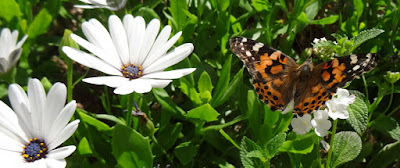The lure of the lapidary lab did not hold the same sway over me that it did over Joani but I did enjoy many hours there bringing out the innate beauty of seemingly ordinary rocks. I carried the boulder, below, up a lot of steps from the beach at the Eldwayne Ocean Park access in Pismo, CA, so I was pleased to find it to be such an interesting specimen when it was sliced. Four well-placed cuts yielded what I hope will be a keepsake set of bookends that will always remind me of our traveling days.
I'm looking forward to giving it a shine!
There was a large tree in the corner of the dog park where a group of chattering peach-faced lovebirds would congregate. I had counted more than a dozen in the tree at one time. This day I was only able to get seven in the frame at once. Eventually, I identified several more haunts where they spent some of their days but I only photographed them in the dog park tree.
I was fascinated by one particular Saguaro on the way to the pool that, according to what we had heard, should have been well over a hundred years old. I suspect regular watering probably makes the park model cacti grow much faster than their desert brethren. When it started to flower, I took the opportunity for some pictures and was pleasantly surprised when a Gila woodpecker joined me for my photo shoot.
California Quail was another staple in the park. They were so funny to watch as they preferred to run unless they absolutely had to fly. When they ran, the little feathered knot on the top of their heads would wobble back and forth looking very comical.
Along with the many varieties of cacti, the park was home to quite a few unusual looking flowers. Some were planted by management and some were on individual lots. It was so late in the season and so few people were still around that I felt pretty comfortable taking pictures throughout the park. Below are some of my favorites.
Bougainvillea
Hibiscus
Nerium oleander
Oleander is one of the most poisonous commonly grown garden plants.
Caesalpinia, bird of paradise
Agave
(one of the 199 known varieties of agave)


























































